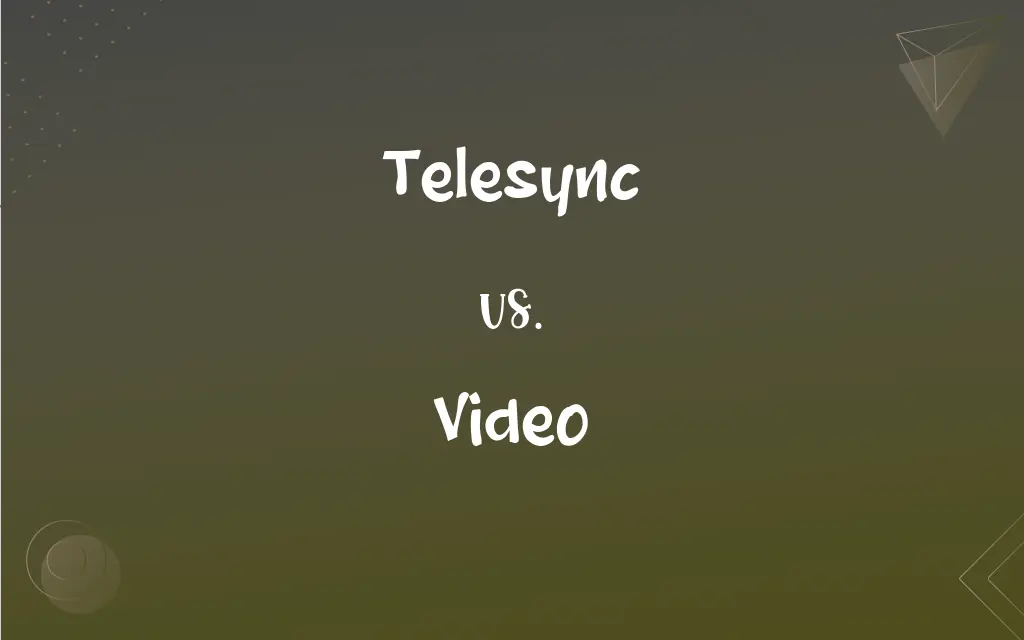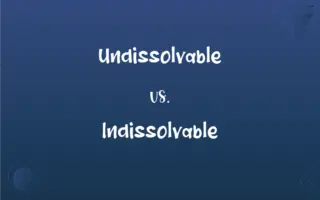Telesync vs. Video: What's the Difference?
By Harlon Moss & Aimie Carlson || Updated on May 23, 2024
Telesync is a bootleg recording of a film, captured with professional equipment in a theater, while video refers to any digital recording or transmission of visual media.

Key Differences
Telesync is a specific type of bootleg recording of a film, typically made with a professional camera in a theater using direct audio feeds for better sound quality. Video, on the other hand, is a broad term encompassing any digital recording or transmission of visual content. This includes movies, television shows, online streaming content, and personal recordings.
Telesync recordings often suffer from issues such as poor image quality due to being filmed from a screen, whereas videos, especially those produced and distributed legally, usually maintain high production standards. Video content can be produced in various formats and resolutions, from standard definition to 4K and beyond.
Telesync's primary use is in the illegal distribution of newly released films, whereas video is used for a wide range of purposes including entertainment, education, communication, and marketing. This wide application makes video a more versatile and accepted medium.
The distribution channels for telesync are typically underground or on illegal websites, while video content is widely distributed through legal platforms like YouTube, Netflix, and television networks. This distinction highlights the legal and ethical differences between the two.
Comparison Chart
Definition
Bootleg recording made in a theater
Any digital recording of visual content
ADVERTISEMENT
Quality
Generally lower quality than official releases
Varies from low to high definition
Legality
Typically illegal
Can be legal or illegal
Distribution
Underground or illegal websites
Legal platforms like YouTube, Netflix
Usage
Primarily for illegal movie distribution
Entertainment, education, marketing
Telesync and Video Definitions
Telesync
An unauthorized film copy captured in a cinema.
They watched a telesync version of the blockbuster at home.
ADVERTISEMENT
Video
Content captured and transmitted electronically.
The concert was broadcast live as a video stream.
Telesync
A pirated movie recorded using direct audio feeds for better sound.
The telesync had clearer audio than typical cam versions.
Video
Digital media format for moving images.
The tutorial was available in video format online.
Telesync
A bootleg film recording made with professional equipment.
The telesync of the new movie was already online hours after its release.
Video
A sequence of visual frames creating moving images.
The video played smoothly on the new smartphone.
Telesync
A cinema-recorded film with higher quality than camcorders.
The telesync was surprisingly good compared to usual pirated copies.
Video
A recording of visual images, typically with sound.
They watched a video of their vacation on the TV.
Telesync
An illegal movie recording shared on the internet.
He downloaded a telesync of the film from a shady website.
Video
A sequence of images processed electronically into an analog or digital format and displayed on a screen with sufficient rapidity as to create the illusion of motion and continuity.
Telesync
A bootlegged video copy of a movie, shot in a movie theater, often with a professional camera on a tripod in the projection booth, and with a direct connection to the sound source.
Video
A signal carrying such images.
Video
A movie recorded electronically, usually including a soundtrack
A video of a birthday party.
Video
The presentation of such a work.
Video
The electronic medium in which such movies are recorded
A movie released on video.
Video
A music video.
Video
Television, television show, movie.
Video
A short film clip, with or without audio (as in a music video, or one of the plethora of user-generated short movies on sites such as YouTube).
We made a video montage of Robbie for his fiftieth birthday.
Check out my new videos on YouTube.
Video
Motion picture stored on VHS or some other format.
Video
(dated) VHS.
Video
(Britain) To record using a video camera, to videotape
Video
(Britain) To record a television program
Video
(ambitransitive) To visually record (activity, or a motion picture) in general, with or without sound.
Video
The visible part of a television transmission;
They could still receive the sound but the picture was gone
Video
A recording of both the video and audio components (especially one containing a recording of a movie or television program)
Video
Broadcasting visual images of stationary or moving objects;
She is a star of screen and video
Television is a medium because it is neither rare nor well done
Video
Media files used for entertainment or informational purposes.
He edited the video before uploading it to his channel.
FAQs
What is a telesync recording?
A telesync recording is a pirated film recorded in a cinema using professional equipment.
What quality can be expected from telesync?
Telesync quality is generally lower than official releases but better than basic camcorder recordings.
How does video differ from telesync?
Video is a general term for any digital recording of visual content, while telesync specifically refers to illegal film recordings in theaters.
Is telesync legal?
No, telesync recordings are illegal as they involve unauthorized duplication and distribution of films.
Where are telesync recordings typically distributed?
Telesync recordings are often distributed through illegal websites and underground networks.
What are common uses for video content?
Video content is used for entertainment, education, marketing, communication, and more.
Can video be both legal and illegal?
Yes, video can be legally produced and distributed or illegally pirated.
How do production standards differ between telesync and video?
Telesync recordings have lower production standards compared to professionally produced videos.
How is the audio quality in telesync recordings?
Audio quality in telesync is usually better than cam recordings due to direct audio feed use.
Why are telesync recordings made?
Telesync recordings are made for illegal distribution, aiming to provide early access to new films.
What formats do video recordings come in?
Video recordings can be in various formats like MP4, AVI, MKV, and in resolutions from standard definition to 4K.
What is the primary source of telesync recordings?
Telesync recordings originate from theaters where films are shown.
How is video distributed legally?
Video is legally distributed through platforms like YouTube, Netflix, and broadcast networks.
What is the audience for telesync recordings?
The audience for telesync recordings typically consists of individuals seeking early access to films without paying.
Are there any legal platforms for telesync recordings?
No, telesync recordings are not available on legal platforms as they are unauthorized copies.
Can video content be edited?
Yes, video content can be edited for quality, content, and length.
What is the typical resolution of telesync recordings?
Telesync recordings typically have lower resolutions compared to high-definition videos.
Is it ethical to watch telesync recordings?
No, it is not ethical to watch telesync recordings as they are illegal and harm the film industry.
What devices can play video content?
Video content can be played on various devices such as computers, smartphones, tablets, and smart TVs.
What kind of visual issues are common in telesync?
Telesync recordings often suffer from poor image quality due to being filmed off a screen.
About Author
Written by
Harlon MossHarlon is a seasoned quality moderator and accomplished content writer for Difference Wiki. An alumnus of the prestigious University of California, he earned his degree in Computer Science. Leveraging his academic background, Harlon brings a meticulous and informed perspective to his work, ensuring content accuracy and excellence.
Co-written by
Aimie CarlsonAimie Carlson, holding a master's degree in English literature, is a fervent English language enthusiast. She lends her writing talents to Difference Wiki, a prominent website that specializes in comparisons, offering readers insightful analyses that both captivate and inform.































































